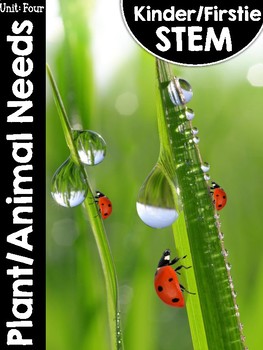Kinder/FirstieSTEM Kindergarten STEM Unit Four: Plant and Animal Needs
- Zip
What educators are saying
Also included in
- Kinder/FirstieSTEM Curriculum Bundle Thanks so much for viewing my Kinder/FirstieSTEM Curriculum units bundled. Kinder/FirstieSTEMCurriculum is an engaging STEM curriculum with young learners in mind! Kinder/FirstieSTEM is standards-based and encourages young learners to think “outside the box” andPrice $15.00Original Price $35.00Save $20.00
Description
Kinder/FirstieSTEM Unit Four: Plant and Animal Needs
This packet is part of my Kinder/FirstieSTEM bundle. Save by purchasing the bundle HERE!
Thanks so much for viewing my Kinder/FirstieSTEM Curriculum unit. Kinder/FirstieSTEM Curriculum is an engaging STEM curriculum with young learners in mind! Kinder/FirstieSTEM is standards-based and encourages young learners to think “outside the box” and prove their thinking through hands-on and engaging learning experiences.
What is STEM?
STEM is the integration (not singular practice) of Science, Technology, Engineering, and Math in an active environment that focuses on student-centered learning. Students are engaged in discovering problems, questioning, problem solving, collaborating, and hands on activities while they face real world issues. Students are encouraged to approach the problem based upon their previous learning. Everyone’s voice matters, all ideas matter and are discussed and attempted. Students evaluate their approach and solution throughout the STEM activity and improve their design as they build and experiment. Teachers are facilitators of thinking and guide students through the problem solving experience.
An Overview of the Kinder/FirstieSTEM unit!
Each unit is broken down into five to seven lessons. ** However, please note that each lesson can take several academic days to complete. Each lesson has the standards covered, materials list, lesson vocabulary, STEM design loop integration, detailed activity lesson plans, and all necessary student recording sheets.
The units also includes vocabulary cards, parent unit overview letter, parent involvement request slips, STEM design loop, and all other necessary supplies. The lessons will at times suggest the integration of online book sources and online video databases to engage the learners into the unit topic. Please note that all student response sheets can be shrunk and placed into a student STEM journal. You can also choose to have students track their daily STEM activities in their STEM journal with or without the included response sheets.
Plant and Animal Needs- In this STEM unit, student will be learning all about the basic needs of plants and animals, will be able to identify plant parts, and will be able to compare and describe various animals. Students will create a habitat for a rainforest animal that will meet their basic needs based on classroom learning.
What About Standards?
The units are based upon commonly phrases state science standards as well as the Next Generation Science Standards! Within the units you'll see those commonly used phrases of science power standards across state to state. Below are additional NGSS!
Unit 4: K-LS1 From Molecules to Organisms: Structures and Processes, K-2-ETS1 Engineering Design
According to the U.S. Department of Education, all STEM jobs in the U.S. will increase 14 percent from 2010-2020, accounting for millions of positions. Yet many will go unfilled, as students are not prepared for an occupation in this field. We can change this, we must change this.
Using a STEM approach in teaching allows students to apply learning that occurred in the four subject areas to a real life problem given by the teacher. Students are able to problem solve in a way that the typical classroom learning does not allow. STEM capitalizes on students’ interests and experiences, builds on what they know and have just learned, and provides them an opportunity to take chances and engage in learning in a different way. Using a STEM model prepares students to investigate questions they have about the world they live in and gives them the tools to solve daily problems they encounter. A STEM enriched classroom sounds different as well; students are conversing, sharing ideas, discussing possibilities, and using learned vocabulary as they experiment together.
As educators, our job is to teach, create compelling learning environments that foster learning for our students, and prepare them to be college, career, and life ready. The use of vocabulary, hands on approach, and collaboration that occurs during these STEM lessons amazes me as a teacher. Some of my students who struggle with reading or math facts excel in STEM lessons. Their confidence builds as their team listens to their ideas; they feel valued and a part of the learning in a way they never have before. These students find new interests, strengths, and set new goals for their future. I learn more about my students while observing them solve problems in a STEM setting then I do in any other situation in the classroom.
* * Be sure to view the preview for a look at the lesson plan set up!
Questions?
Please email me at littlemindsatworkllc@gmail.com
Would you like to receive notifications for my newly released packets and upcoming sale? Be sure to FOLLOW ME here on TPT!
**Join my private Facebook Group to join fellow Pre-K, Kindergarten, First Grade and Second Grade teachers that use my curriculum! Collaborate, chat and share ideas with like-minded teachers! Join the private Facebook group H E R E!
Visit my blog Little Minds at Work
Follow me on Facebook



